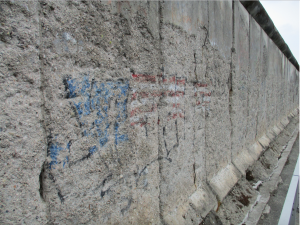The final stop on my study abroad tour brought me to Berlin, Germany from May 26 to May 31. Serving as the culmination of our efforts to study the European theater of World War II, we visited German and Soviet memorials as well as museums like the German Resistance museum and the SS museum. In addition, we visited the Reichstag, the place where the German parliament operates and also the location of an intense battle between Nazi and Soviet forces in the closing days of World War II. During my time in Germany, I was able to pinpoint an interesting cultural difference that I was surprised to encounter. In the United States, we love security. We’re hesitant to trust and we are big on making sure everything is fair. This is not always the same as what I’ve seen in Germany.
When I’m at school in Columbus, I work at a job downtown. I have to use the bus system to get to work every day. Every time I want to board the bus, I have to swipe my card. If I don’t have my card, I won’t be able to get on the bus. That’s the way it is. In Germany, we got a pass to use the rail and bus system in Berlin. After we had it activated on our first ride, we never had to show it again. We merely had to walk into a station and board the train we needed. There were no ticket machines. We were told that occasionally men would walk around and check for tickets. However, I never saw them. This was even different from Paris and London, where we had to swipe our passes every time we wanted to enter the metro.
Restaurants in Berlin were a place where I also noticed a cultural divide. In the United States, it is not rare for people well older than the drinking age to be carded. In Europe, I was never carded. I don’t think I can pass as an 18 year old anymore (the drinking age in most European countries), but I think there is a point to this. The Germans seemed more willing to trust the word of others. When we were done with our meal, we would often just walk up to the register and tell them what we ordered before paying. They took my word for it every time. This is unlike the American way of bringing checks to tables already detailing each expense.
The last three weeks have been the wildest adventure of my life. England, France, Poland and now Germany have each offered me insight into different ways of life. This trip has given me so much that I know I have not only learned a lot and had many incredible experiences, but I have also grown as a person. In both big and small ways, my perspective has changed. For example, I had never previously had to pay to go to the bathroom. Now, I pull out my wallet every time I approach a restroom (not a big fan of this cultural difference). Being abroad has made me appreciate my life in the United States even more. The simple pleasures that we never take the time to appreciate have made me feel so blessed to be an American. At the same time, there is so much more to be seen in the world that doesn’t include free wifi, four bedroom houses in the subdivisions and modern skyscrapers. If you search, you will find. I found out many simple things. There are still old-fashioned squares where people gather to sell artwork and other materials (Krakow). If you try hard enough, you can take a picture that includes both an 800 year old prison and a modern skyscraper (London). I would have never guessed it was so easy to actually get lost in a museum (Louvre – Paris). Study abroad has made me realize that the world is out there waiting for you. Waiting to transform, enlighten or amaze you. A broadened perspective awaits on the other side. My sense of place has come in to question, but only in the way that I now see myself as a piece in an interconnected, global puzzle instead of on an island. What I learned abroad isn’t something you can take notes on in class or watch a video about. It’s an experience that can’t be tested or graded. You have to live it.
Thank you for following my journey,
Ben













